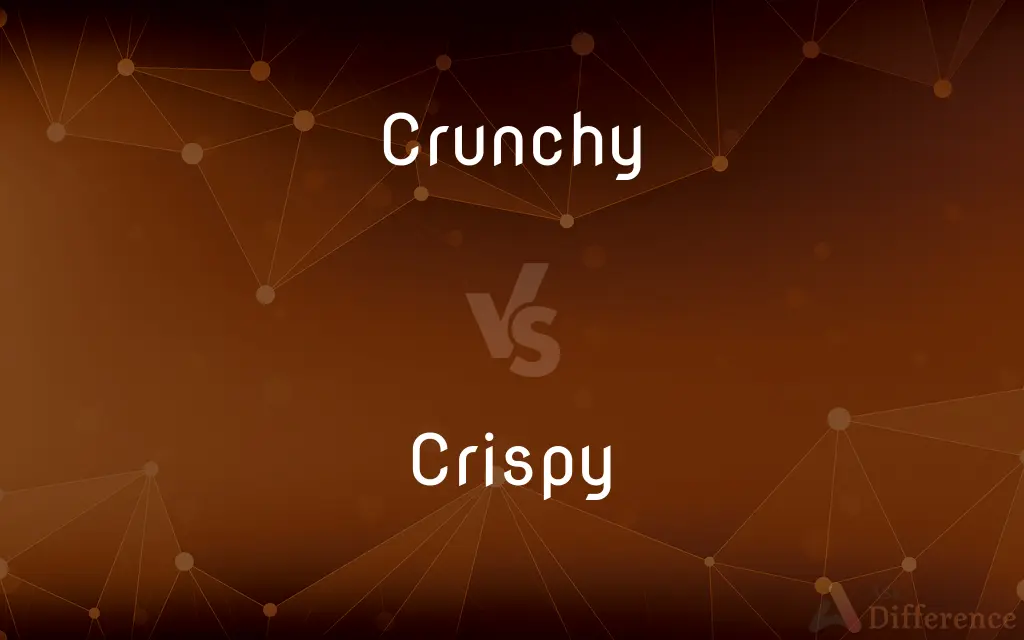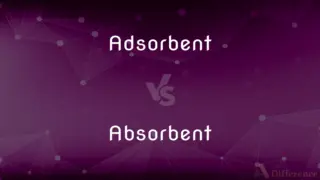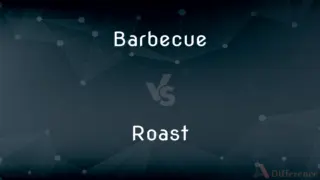Crunchy vs. Crispy — What's the Difference?
By Tayyaba Rehman & Fiza Rafique — Updated on March 8, 2024
Crunchy and crispy are both textures often described in food, but they convey distinct sensory experiences. Crunchy foods have a firmer and more resistant texture, requiring more force to break, while crispy foods are lighter and break or shatter easily.

Difference Between Crunchy and Crispy
Table of Contents
ADVERTISEMENT
Key Differences
Crunchy foods are characterized by their firm and often dense texture that makes a distinct sound when broken or chewed. This texture is commonly found in foods like raw vegetables, nuts, and certain candies. The sensation of crunchiness involves a more substantial bite and a louder, more resonant sound. On the other hand, crispy foods are generally thinner and more delicate, producing a lighter, more brittle sound when eaten. This texture is typical of foods that have been fried or baked to a light, airy consistency, such as potato chips, crackers, and certain types of pastry. The key to achieving a crispy texture often lies in the removal of moisture, allowing the food to attain a fragile, easily shattered structure.
The cooking method plays a significant role in differentiating crunchy from crispy textures. For example, the longer cooking times and lower temperatures used to roast nuts can create a crunchy texture, while the high heat and quick cooking of frying can render foods crispy.
Moisture content is another critical factor. Crunchy foods may retain more internal moisture, contributing to their denser texture, whereas crispy foods typically have much of their moisture content removed, either through cooking or by the nature of the food itself, resulting in their lighter, airier feel.
In terms of nutritional aspects, the distinction between crunchy and crispy can sometimes align with health considerations. Crunchy foods, such as fresh vegetables and nuts, are often rich in nutrients and fiber, while crispy foods, especially those that are fried, can be higher in fats and calories due to the cooking processes involved.
Comparison Chart
Texture
Firm and dense, requiring more force
Light and delicate, easily shattered
ADVERTISEMENT
Sound
Louder, more resonant when chewed
Lighter, more brittle sound
Common Foods
Raw vegetables, nuts, hard candies
Fried foods, chips, crackers, pastries
Cooking Method
Often involves roasting or baking
Often involves frying or baking at high heat
Moisture Content
Retains more internal moisture
Moisture is largely removed
Compare with Definitions
Crunchy
Firm and making a sharp noise when bitten or crushed.
The crunchy carrots added texture to the salad.
Crispy
Thin and easily broken or cracked, with a delicate texture.
The crispy potato chips were a perfect snack.
Crunchy
Characterized by a distinct textural quality that enhances the eating experience.
The crunchy toppings made the ice cream sundae even more delightful.
Crispy
Light and brittle, often resulting from being fried or baked.
She savored the crispy edges of the roasted chicken.
Crunchy
Substantial in texture and resistant to pressure.
She enjoyed the crunchy crust of the freshly baked bread.
Crispy
Having a flaky or airy quality that crumbles easily.
The crispy pastry was a delectable part of the morning routine.
Crunchy
Producing a loud, satisfying sound when eaten.
The crunchy leaves underfoot signaled the arrival of fall.
Crispy
Characterized by a slight crackling sound when broken or bitten.
The crispy bacon added a savory crunch to the breakfast plate.
Crunchy
Dense and capable of withstanding chewing.
The granola bars were pleasantly crunchy and filling.
Crispy
Tending to break or snap easily under pressure, often in a satisfying manner.
The crispy crackers were an ideal accompaniment to the soup.
Crunchy
Making a crunching or cracking sound, as when chewed; crisp
Crunchy fresh vegetables.
Crispy
Firm but easily broken or crumbled; crisp.
Crunchy
(Slang) Crunchy-granola
"If they're crunchy types, consider camping out along the way instead of staying at motels" (Jennifer Hanson).
Crispy
Having small curls, waves, or ripples.
Crunchy
Likely to crunch, especially with reference to food when it is eaten.
I put some lettuce in the burger to make it more crunchy.
Crispy
Having a crisp texture; brittle yet tender.
These biscuits are very crispy.
Baked rolls should be crispy.
Crunchy
(slang) Having sensibilities of a counter-culture nature lover or hippie; derived from the concept of crunchy granola.
San Francisco is a very crunchy town.
Crispy
(informal) The well-baked fat on the surface of a piece of roasted meat.
Crunchy
A pellet of dry cat food.
Crispy
Formed into short, close ringlets; frizzed; crisp; as, crispy locks.
Crunchy
Pleasingly firm and fresh and making a crunching noise when chewed;
Crisp carrot and celery sticks
A firm apple
Crunchy lettuce
Crispy
Crisp; brittle; as, a crispy pie crust.
Crispy
Tender and brittle;
Crisp potato chips
Common Curiosities
How does cooking temperature affect crispiness?
Higher cooking temperatures can remove moisture more effectively, making foods crispy.
Is crunchy food healthier than crispy food?
It depends on the specific foods and cooking methods, but crunchy foods like raw vegetables and nuts often retain more nutrients.
Can baking make a food crispy?
Yes, baking can make foods crispy, especially if done at high temperatures with minimal moisture, allowing the surface to become golden and brittle.
Does the thickness of food affect its texture?
Yes, thicker foods are more likely to be crunchy, while thinner foods are more prone to become crispy when cooked.
Why do fried foods often turn out crispy?
Fried foods become crispy due to the high heat of the oil quickly removing surface moisture, creating a light and brittle texture.
How does the thickness of a food's coating affect its texture?
A thicker coating can lead to a crunchier texture, as it provides more structure and resistance, while a thinner coating is more likely to yield a crispy finish.
What makes a food crunchy?
Foods become crunchy typically through a combination of their natural structure and the cooking method, which might include baking or roasting.
How do you maintain the crispiness of food?
To maintain crispiness, keep foods uncovered and in a dry environment to prevent moisture absorption, which can make them soggy.
How does the type of oil affect the crispiness of fried foods?
The type of oil, its smoking point, and freshness can influence how effectively it crisps food, with higher smoking point oils generally being better for frying.
Can a food be both crunchy and crispy?
Some foods may have both textures, with a crispy exterior and a crunchy interior, depending on how they are cooked.
Are all nuts considered crunchy?
Most nuts are considered crunchy due to their dense structure, but the level of crunchiness can vary depending on the type and how they're prepared.
Can freezing affect the crunchiness or crispiness of food?
Freezing can affect textures; it can make some foods, like vegetables, less crunchy, and can impact the crispiness of fried foods upon reheating.
What's the role of moisture in making foods crunchy or crispy?
Moisture content is crucial; removing moisture through cooking makes foods crispy, while some internal moisture can contribute to a crunchy texture.
Is it possible to make healthy crispy snacks?
Yes, using methods like air frying, baking, or dehydrating can produce crispy snacks with less oil and fat than traditional frying methods.
How do ingredients like breadcrumbs or batter contribute to texture?
Coatings like breadcrumbs or batter can add a layer of texture, making foods crispier when fried or baked, as they create a protective layer that crisps up.
Share Your Discovery

Previous Comparison
Adsorbent vs. Absorbent
Next Comparison
Barbecue vs. RoastAuthor Spotlight
Written by
Tayyaba RehmanTayyaba Rehman is a distinguished writer, currently serving as a primary contributor to askdifference.com. As a researcher in semantics and etymology, Tayyaba's passion for the complexity of languages and their distinctions has found a perfect home on the platform. Tayyaba delves into the intricacies of language, distinguishing between commonly confused words and phrases, thereby providing clarity for readers worldwide.
Co-written by
Fiza RafiqueFiza Rafique is a skilled content writer at AskDifference.com, where she meticulously refines and enhances written pieces. Drawing from her vast editorial expertise, Fiza ensures clarity, accuracy, and precision in every article. Passionate about language, she continually seeks to elevate the quality of content for readers worldwide.
















































